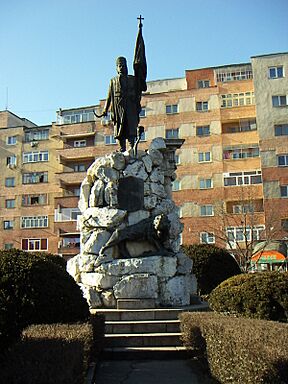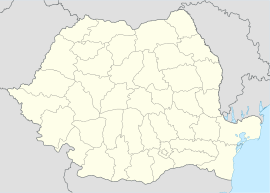Târgu Jiu facts for kids
Quick facts for kids
Târgu Jiu
|
||
|---|---|---|
|
Tudor Vladimirescu monument
Tudor Vladimirescu National College
City Hall
Holy Archangels Church and Gorj County Prefecture
Ecaterina Teodoroiu Memorial House
City center
|
||
|
||

Location in Gorj County
|
||
| Country | ||
| County | Gorj | |
| Established | 1406 (first official record as Jiul) | |
| Subdivisions | Bârsești, Drăgoieni, Iezureni, Polata, Preajba Mare, Romanești, Slobozia, Ursați | |
| Area | 102 km2 (39 sq mi) | |
| Highest elevation | 326 m (1,070 ft) | |
| Lowest elevation | 210 m (690 ft) | |
| Population
(2011)
|
Lua error in Module:Wd at line 1,575: attempt to index field 'wikibase' (a nil value). | |
| Time zone | EET/EEST (UTC+2/+3) | |
| Postal code |
200xyz
|
|
| Area code | +40 x53 | |
Târgu Jiu is the main city of Gorj County in the Oltenia region of Romania. It is located in the southern part of the Carpathian Mountains, right by the Jiu River. The city also manages eight smaller towns and villages: Bârsești, Drăgoieni, Iezureni, Polata, Preajba Mare, Romanești, Slobozia, and Ursați.
Târgu Jiu is famous for the amazing Sculptural Ensemble of Constantin Brâncuși. These sculptures were recognized as a World Heritage Site by UNESCO in 2024, meaning they are very important to the whole world!
Contents
History of Târgu Jiu
The city gets its name from the Jiu River, which flows through it. A long, long time ago, in ancient times, there was a Dacian village here. It was surrounded by thick forests.
After the Romans took over the Oltenia region around 101-102 AD, they set up military camps. These camps were near roads that connected important places. When workers were building the Târgu Jiu - Rovinari railroad, they found old Roman items. These included mosaics, coins, pottery, and bricks. This shows that Târgu Jiu was likely a trading town, or vicus, when the Roman Empire ruled. A very important road linking the Danube River to Transylvania passed through the city. Historians believe that part of the Roman army, led by Trajan, stayed here.
Even after the Roman army left in 271 AD, the area remained under Roman influence. This was partly because Constantine The Great wanted to keep Oltenia under his rule. To show how important this area was, Constantine built a huge bridge over the Danube River. It was over 2400 meters long, one of the longest bridges ever built!
In the 13th century, this land was ruled by Litovoi, a Romanian leader called a voivode. His territory covered northern Oltenia. Litovoi is first mentioned in a document from 1247. Later, around 1277, Litovoi fought against the Hungarians. He refused to pay taxes for lands that the Hungarian King Ladislaus IV of Hungary claimed. Litovoi was sadly killed in this battle.
The first official mention of Târgu Jiu as a city was in a document from November 23, 1406. This order was signed by Mircea cel Batran, a famous ruler. Since 1497, Târgu Jiu has been the main city of Gorj County.
Constantin Brâncuși, a world-famous sculptor, grew up here. In 1938, he created a special memorial for the soldiers of World War I. This memorial is called Calea Eroilor, or "Heroes' Street." His large sculptures are now the biggest tourist attractions in Târgu Jiu. These include The Table of Silence, Stool Alley, The Gate of the Kiss, and The Endless Column. The Endless Column is even shown on the city's coat of arms! In the 1950s, some leaders wanted to destroy Brâncuși's art, but luckily, they didn't.
The Târgu Jiu internment camp was a place where people were held during World War II. It was used as a regular prison before and after the war.
Starting in the 1960s, the city grew quickly because of coal mining. Other important industries here include wood processing, making machines, textiles (like clothes), glass, and building materials such as cement and bricks.
In 1992, a university was opened in Târgu Jiu, named after the famous sculptor, Brâncuși.
Brâncuși's Amazing Sculptures
Brâncuși's art in Târgu Jiu is truly special and "revolutionary." His sculptures are not just beautiful art; they are also useful! For example, some are seats, a gateway, or a huge marker.
What's really cool is how these sculptures fit into the city. They are part of the city's design in a very important way. When you walk through the entire sculpture area, it's a unique experience. The sculptures stand out, yet they also blend in with the everyday city life. Brâncuși's work brings together different ideas in a "completely unique" way in Târgu Jiu. Even with the city's normal buildings, his art makes Târgu Jiu a special place. It's amazing how a small Romanian city has such world-famous art that is part of its daily life.
Târgu Jiu's Coat of Arms
The coat of arms for Târgu Jiu has a shield with seven towers. In the middle of the shield, you can see Constantin Brâncuși's famous Endless Column. This column is a symbol of Romanian art and culture.
On both sides of the column, there is a golden lion holding a black sword. These lions look like they are "guarding" the column. The lion is a very old symbol of the Oltenia region. People think it came from the symbol of a Roman army group, the 13th Legion "Gemina." The lion shows the bravery and fighting spirit of the people who live in Târgu Jiu.
Population of Târgu Jiu
| Historical population | ||
|---|---|---|
| Year | Pop. | ±% |
| 1889 | 4,076 | — |
| 1900 | 6,634 | +62.8% |
| 1940 | 26,634 | +301.5% |
| 2002 | 96,641 | +262.8% |
| 2011 | 80,548 | −16.7% |
| 2021 | 73,545 | −8.7% |
| Source: INS, Census data | ||
At the 2021 census, Târgu Jiu had about 73,545 people living there. In the 2011 census, there were 78,553 people. Most of them, about 96%, were Romanians. About 3.4% were Romani people, and a small number were from other groups.
Getting Around Târgu Jiu
- The city has a public transport system with 2 trolleybus lines and 8 bus lines. It's run by a company called S.C. Transloc. S.A. A single ticket costs about €0.60 (around 60 cents) as of 2023.
- The main train station is on Republicii Boulevard. It was rebuilt after the Romanian Revolution in 1989.
- Târgu Jiu has five main boulevards: Constantin Brâncuși, Nicolae Titulescu, Republicii, Ecaterina Teodoroiu, and Unirii. The most important street is Calea Victoriei (Victory Avenue). The longest boulevard is Ecaterina Teodoroiu Boulevard.
- Important roads, like European route E79 and national road DN67, pass through Târgu Jiu. These roads connect the city to other places like Drobeta-Turnu Severin to the west and Râmnicu Vâlcea to the east.
Images for kids
-
Tudor Arghezi Library
Education in Târgu Jiu
Here are some of the main high schools in the city:
- National College "Ecaterina Teodoroiu"
- Tudor Vladimirescu National College
- Constantin Brăiloiu Music and Arts High School
- National College "Spiru Haret"
- Colegiul Comercial "Virgil Madgearu"
- Colegiul Tehnic "General Gheorghe Magheru"
- Scholar Group Energetic Nr. 1"
There is also one university in Târgu Jiu:
- Constantin Brâncuși University
Sports Teams
The main football team in Târgu Jiu is Pandurii. They have played in Romania's top league, Liga I, for 12 seasons. Their best finish was second place in the 2012–13 season. Pandurii has also played in European competitions twice, even reaching the group stages of the 2013–14 UEFA Europa League.
The city also has a basketball team, CSM Târgu Jiu, which plays in Liga Națională. There are two handball teams: UCB Târgu Jiu (men's) and CSM Târgu Jiu (women's), which plays in Liga Florilor.
Twin Cities
Târgu Jiu is connected with these cities around the world:
 Forbach, France
Forbach, France Lauchhammer, Germany
Lauchhammer, Germany Noci, Italy
Noci, Italy Pendik, Turkey
Pendik, Turkey Yambol, Bulgaria
Yambol, Bulgaria
Famous People from Târgu Jiu
- Ecaterina Teodoroiu (1894–1917), a brave heroine from World War I.
- Horațiu Mălăele (born 1952), a well-known actor.
- Cătălin Măruță (born 1978), a popular TV host.
- Sergiu Nicolaescu (1930–2013), a famous film director and actor.
- Gheorghe Tătărescu (1886–1957), who was a lawyer and served as Prime Minister of Romania.
- Emil Ungureanu (1936–2012), a chess master.
See also
 In Spanish: Târgu Jiu para niños
In Spanish: Târgu Jiu para niños

















